外研版(2019)选择性必修 第三册Unit 1 Face values Developing ideas Reading课件(共24张ppt)
文档属性
| 名称 | 外研版(2019)选择性必修 第三册Unit 1 Face values Developing ideas Reading课件(共24张ppt) |  | |
| 格式 | pptx | ||
| 文件大小 | 16.7MB | ||
| 资源类型 | 教案 | ||
| 版本资源 | 外研版(2019) | ||
| 科目 | 英语 | ||
| 更新时间 | 2025-04-28 20:41:22 | ||
图片预览

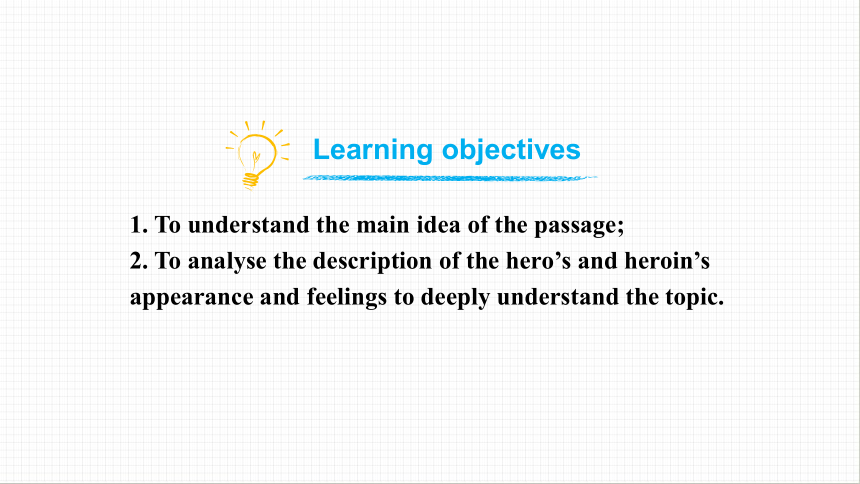
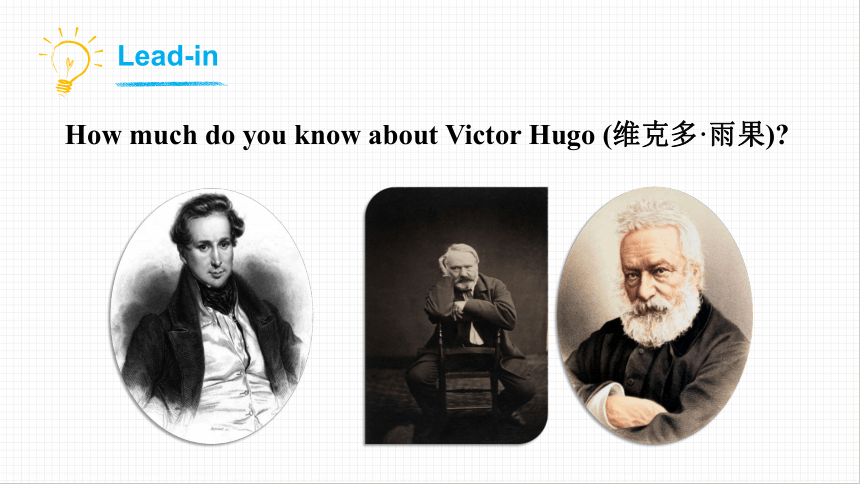
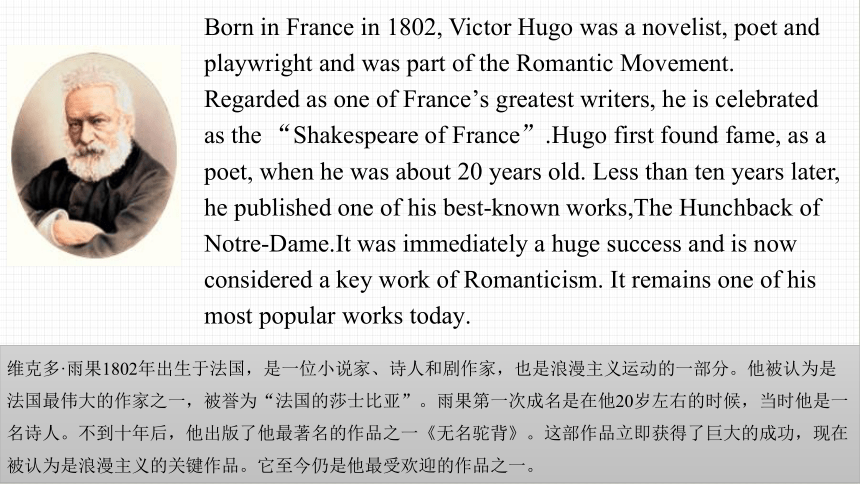
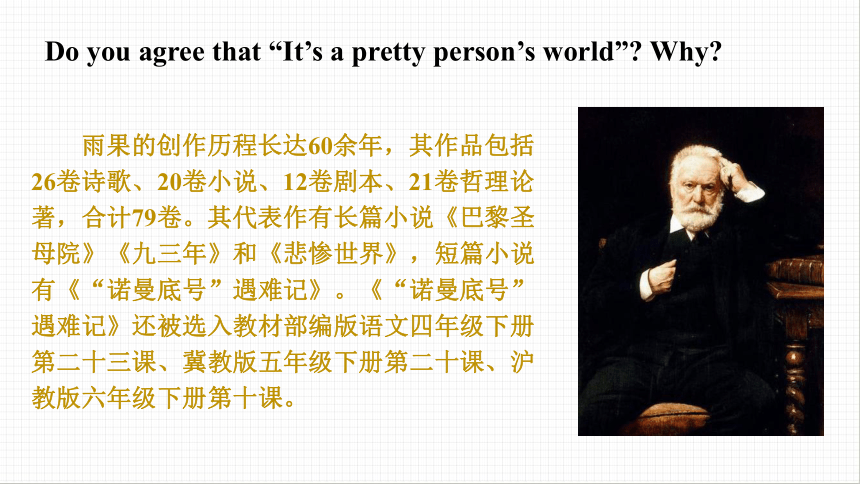
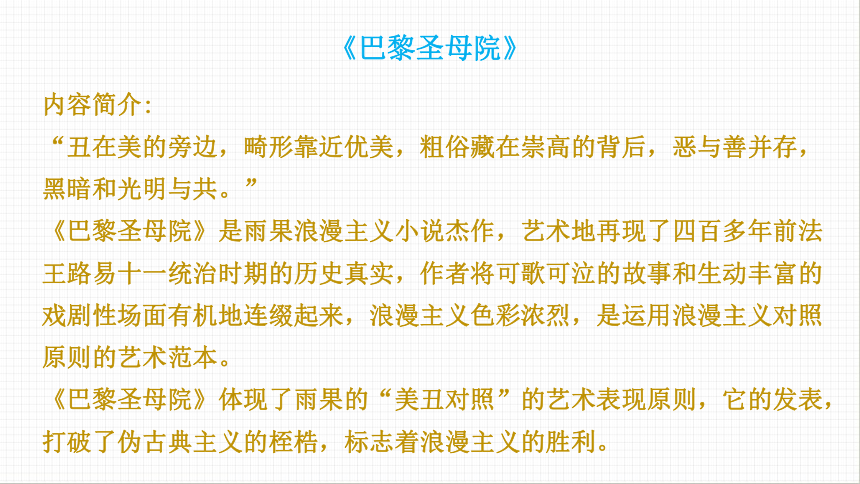
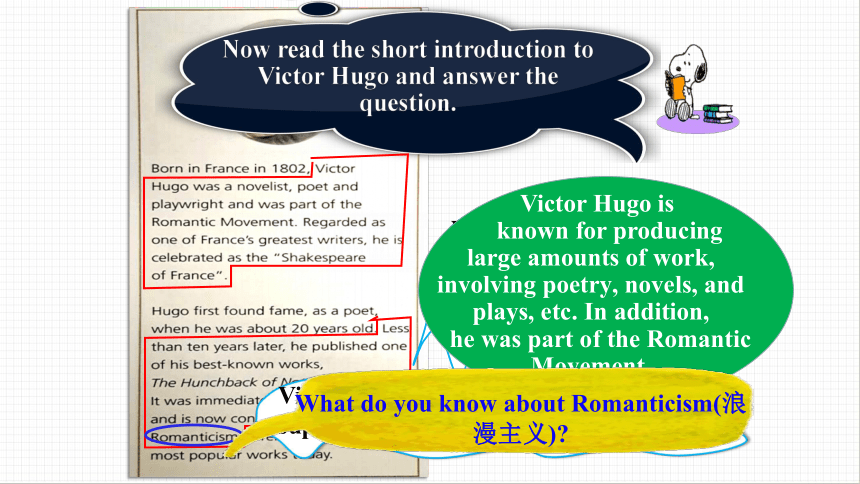

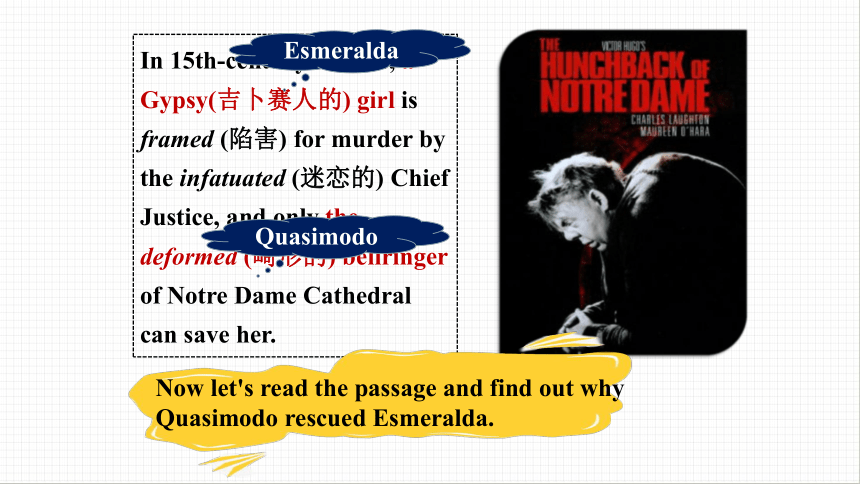
文档简介
(共24张PPT)
Unit 1 Face Values
Developing Ideas
Learning objectives
1. To understand the main idea of the passage;
2. To analyse the description of the hero’s and heroin’s appearance and feelings to deeply understand the topic.
How much do you know about Victor Hugo (维克多·雨果)
Lead-in
Born in France in 1802, Victor Hugo was a novelist, poet and playwright and was part of the Romantic Movement. Regarded as one of France’s greatest writers, he is celebrated as the “Shakespeare of France”.Hugo first found fame, as a poet, when he was about 20 years old. Less than ten years later, he published one of his best-known works,The Hunchback of Notre-Dame.It was immediately a huge success and is now considered a key work of Romanticism. It remains one of his most popular works today.
维克多·雨果1802年出生于法国,是一位小说家、诗人和剧作家,也是浪漫主义运动的一部分。他被认为是法国最伟大的作家之一,被誉为“法国的莎士比亚”。雨果第一次成名是在他20岁左右的时候,当时他是一名诗人。不到十年后,他出版了他最著名的作品之一《无名驼背》。这部作品立即获得了巨大的成功,现在被认为是浪漫主义的关键作品。它至今仍是他最受欢迎的作品之一。
Do you agree that “It’s a pretty person’s world” Why
雨果的创作历程长达60余年,其作品包括26卷诗歌、20卷小说、12卷剧本、21卷哲理论著,合计79卷。其代表作有长篇小说《巴黎圣母院》《九三年》和《悲惨世界》,短篇小说有《“诺曼底号”遇难记》。《“诺曼底号”遇难记》还被选入教材部编版语文四年级下册第二十三课、冀教版五年级下册第二十课、沪教版六年级下册第十课。
《巴黎圣母院》
内容简介:
“丑在美的旁边,畸形靠近优美,粗俗藏在崇高的背后,恶与善并存,黑暗和光明与共。”
《巴黎圣母院》是雨果浪漫主义小说杰作,艺术地再现了四百多年前法王路易十一统治时期的历史真实,作者将可歌可泣的故事和生动丰富的戏剧性场面有机地连缀起来,浪漫主义色彩浓烈,是运用浪漫主义对照原则的艺术范本。
《巴黎圣母院》体现了雨果的“美丑对照”的艺术表现原则,它的发表,打破了伪古典主义的桎梏,标志着浪漫主义的胜利。
Why do you think Victor Hugo is known as the “Shakespeare of France”
Victor Hugo is
known for producing
large amounts of work, involving poetry, novels, and plays, etc. In addition,
he was part of the Romantic Movement.
Now read the short introduction to Victor Hugo and answer the question.
Victor Hugo is regarded by many as the supreme poet of French Romanticism.
What do you know about Romanticism(浪漫主义)
Romanticism: a style in the 1800s that emphasized a free form of writing and expressed strong emotions, experiences of common people, and imaginative expressions and passion.
In 1831 Hugo published his novel The Hunchback of Notre-Dame. It is now considered a key work of Romanticism.
In 15th-century France, a Gypsy(吉卜赛人的) girl is framed (陷害) for murder by the infatuated (迷恋的) Chief Justice, and only the deformed (畸形的) bellringer of Notre Dame Cathedral can save her.
Esmeralda
Quasimodo
Now let's read the passage and find out why Quasimodo rescued Esmeralda.
※ Why did Quasimodo rescue Esmeralda
A. Because Quasimodo is so ugly, while Esmeralda is beautiful and kind.
B. Because Quasimodo fell in love with Esmeralda.
C. Because Esmeralda was the only one to show him kindness and mercy when Quasimodo was tortured in public.
Task 1 Look through the passage and choose the best answer.
Esmeralda in Quasimodo's eyes
________________
________________
________________
________________
Quasimodo in Esmeralda's eyes
__________________
__________________
__________________
__________________
Task 2 Underline the sentences that describe Esmeralda and Quasimodo's appearances and feelings. Write a short paragraph to describe how Esmeralda and Quasimodo see each other.
Quasimodo in Esmeralda's eye:
Esmeralda thought Quasimodo was repulsive with knock knees, a hunched back and a single
eye; yet beneath his ugliness, he was full of melancholy and gentleness.
Esmeralda in Quasimodo's eye:
Quasimodo thought Esmeralda was graceful and exquisitely beautiful, like a ray of sunshine, a drop of dew or a birdsong.
Task 3 Read the passage again and discuss the following question.
How did Esmeralda's feelings towards Quasimodo change
thought he was horrible
felt sympathetic towards him
knew him better
was patient with him and was moved by him
What does the sentence “A tear swam in the eye of Quasimodo, but did not fall” tell us about Quasimodo's personality
Task 4 Think & Share.
On one hand, it shows that Quasimodo is sensitive and gentle; on the other hand, it shows his strength and pride.
Quasimodo:
Esmeralda:
kind, beautiful,
warm-hearted,
sympathetic
ugly,unfortunate, kind ,brave.
appearance: repulsive--
knock knees, ________ back; single eye; horrible; poor unfortunate monster; savage creature; coarser, downtrodden and plainer than a pebble.
actions: smiled sadly; began to laugh;
a tear in the eye
words: the first to break the ________. ...that is more than I can repay with my life.
feelings: an immense pity;
appearance: graceful; exquisite beauty; a ray of sunshine, a drop of dew, a birdsong;
words: “Poor wretch”
feeling: beyond her ______________; there was melancholy and ___________; listen to him with _________tenderness.
hunched
silence
The Hunchback of Notre-Dame
hero & character
description
gentleness
comprehension
profound
Task 5 Fill in the blanks and try to retell the passage according to them.
Task 6 Work in groups. Give a talk about the character in the passage that makes the greatest impression on you.
What is the character like
___________________________________
Has he/she experienced any emotional
changes If so, what changes are they
___________________________________
What can you learn from him/her
___________________________________
1
Organize your ideas by considering the questions
The impressive
character
character
emotional changes
something you've learned
2
3
Present your ideas in your group.
ugly, disloyal, clever, warm-hearted,
sympathetic, upright, serious, selfless ...
thought he was horrible -felt sympathetic towards him-knew him better-was patient with him and was moved by him
Collect all your group's ideas and present them to the class.
inner beauty,...
1. What difficulties might people like Quasimodo face in the real world How should people treat them
2. Predict what happens next. Share your ideaswith the class.
Read the novel and check your prediction.
Discussion
In what different ways do the two reading passages in this unit raise our awareness of physical appearance and personal qualities
◆ The first passage shows the true meaning of beauty. Though how you present yourself to others plays a part, accepting yourself and feeling confident about your physical appearance are most important.
◆ The second passage highlights how someone's physical appearance can actually be a complete contrast to who they are on the inside.
Conclusion
Unit 1 Face Values
Developing Ideas
Learning objectives
1. To understand the main idea of the passage;
2. To analyse the description of the hero’s and heroin’s appearance and feelings to deeply understand the topic.
How much do you know about Victor Hugo (维克多·雨果)
Lead-in
Born in France in 1802, Victor Hugo was a novelist, poet and playwright and was part of the Romantic Movement. Regarded as one of France’s greatest writers, he is celebrated as the “Shakespeare of France”.Hugo first found fame, as a poet, when he was about 20 years old. Less than ten years later, he published one of his best-known works,The Hunchback of Notre-Dame.It was immediately a huge success and is now considered a key work of Romanticism. It remains one of his most popular works today.
维克多·雨果1802年出生于法国,是一位小说家、诗人和剧作家,也是浪漫主义运动的一部分。他被认为是法国最伟大的作家之一,被誉为“法国的莎士比亚”。雨果第一次成名是在他20岁左右的时候,当时他是一名诗人。不到十年后,他出版了他最著名的作品之一《无名驼背》。这部作品立即获得了巨大的成功,现在被认为是浪漫主义的关键作品。它至今仍是他最受欢迎的作品之一。
Do you agree that “It’s a pretty person’s world” Why
雨果的创作历程长达60余年,其作品包括26卷诗歌、20卷小说、12卷剧本、21卷哲理论著,合计79卷。其代表作有长篇小说《巴黎圣母院》《九三年》和《悲惨世界》,短篇小说有《“诺曼底号”遇难记》。《“诺曼底号”遇难记》还被选入教材部编版语文四年级下册第二十三课、冀教版五年级下册第二十课、沪教版六年级下册第十课。
《巴黎圣母院》
内容简介:
“丑在美的旁边,畸形靠近优美,粗俗藏在崇高的背后,恶与善并存,黑暗和光明与共。”
《巴黎圣母院》是雨果浪漫主义小说杰作,艺术地再现了四百多年前法王路易十一统治时期的历史真实,作者将可歌可泣的故事和生动丰富的戏剧性场面有机地连缀起来,浪漫主义色彩浓烈,是运用浪漫主义对照原则的艺术范本。
《巴黎圣母院》体现了雨果的“美丑对照”的艺术表现原则,它的发表,打破了伪古典主义的桎梏,标志着浪漫主义的胜利。
Why do you think Victor Hugo is known as the “Shakespeare of France”
Victor Hugo is
known for producing
large amounts of work, involving poetry, novels, and plays, etc. In addition,
he was part of the Romantic Movement.
Now read the short introduction to Victor Hugo and answer the question.
Victor Hugo is regarded by many as the supreme poet of French Romanticism.
What do you know about Romanticism(浪漫主义)
Romanticism: a style in the 1800s that emphasized a free form of writing and expressed strong emotions, experiences of common people, and imaginative expressions and passion.
In 1831 Hugo published his novel The Hunchback of Notre-Dame. It is now considered a key work of Romanticism.
In 15th-century France, a Gypsy(吉卜赛人的) girl is framed (陷害) for murder by the infatuated (迷恋的) Chief Justice, and only the deformed (畸形的) bellringer of Notre Dame Cathedral can save her.
Esmeralda
Quasimodo
Now let's read the passage and find out why Quasimodo rescued Esmeralda.
※ Why did Quasimodo rescue Esmeralda
A. Because Quasimodo is so ugly, while Esmeralda is beautiful and kind.
B. Because Quasimodo fell in love with Esmeralda.
C. Because Esmeralda was the only one to show him kindness and mercy when Quasimodo was tortured in public.
Task 1 Look through the passage and choose the best answer.
Esmeralda in Quasimodo's eyes
________________
________________
________________
________________
Quasimodo in Esmeralda's eyes
__________________
__________________
__________________
__________________
Task 2 Underline the sentences that describe Esmeralda and Quasimodo's appearances and feelings. Write a short paragraph to describe how Esmeralda and Quasimodo see each other.
Quasimodo in Esmeralda's eye:
Esmeralda thought Quasimodo was repulsive with knock knees, a hunched back and a single
eye; yet beneath his ugliness, he was full of melancholy and gentleness.
Esmeralda in Quasimodo's eye:
Quasimodo thought Esmeralda was graceful and exquisitely beautiful, like a ray of sunshine, a drop of dew or a birdsong.
Task 3 Read the passage again and discuss the following question.
How did Esmeralda's feelings towards Quasimodo change
thought he was horrible
felt sympathetic towards him
knew him better
was patient with him and was moved by him
What does the sentence “A tear swam in the eye of Quasimodo, but did not fall” tell us about Quasimodo's personality
Task 4 Think & Share.
On one hand, it shows that Quasimodo is sensitive and gentle; on the other hand, it shows his strength and pride.
Quasimodo:
Esmeralda:
kind, beautiful,
warm-hearted,
sympathetic
ugly,unfortunate, kind ,brave.
appearance: repulsive--
knock knees, ________ back; single eye; horrible; poor unfortunate monster; savage creature; coarser, downtrodden and plainer than a pebble.
actions: smiled sadly; began to laugh;
a tear in the eye
words: the first to break the ________. ...that is more than I can repay with my life.
feelings: an immense pity;
appearance: graceful; exquisite beauty; a ray of sunshine, a drop of dew, a birdsong;
words: “Poor wretch”
feeling: beyond her ______________; there was melancholy and ___________; listen to him with _________tenderness.
hunched
silence
The Hunchback of Notre-Dame
hero & character
description
gentleness
comprehension
profound
Task 5 Fill in the blanks and try to retell the passage according to them.
Task 6 Work in groups. Give a talk about the character in the passage that makes the greatest impression on you.
What is the character like
___________________________________
Has he/she experienced any emotional
changes If so, what changes are they
___________________________________
What can you learn from him/her
___________________________________
1
Organize your ideas by considering the questions
The impressive
character
character
emotional changes
something you've learned
2
3
Present your ideas in your group.
ugly, disloyal, clever, warm-hearted,
sympathetic, upright, serious, selfless ...
thought he was horrible -felt sympathetic towards him-knew him better-was patient with him and was moved by him
Collect all your group's ideas and present them to the class.
inner beauty,...
1. What difficulties might people like Quasimodo face in the real world How should people treat them
2. Predict what happens next. Share your ideaswith the class.
Read the novel and check your prediction.
Discussion
In what different ways do the two reading passages in this unit raise our awareness of physical appearance and personal qualities
◆ The first passage shows the true meaning of beauty. Though how you present yourself to others plays a part, accepting yourself and feeling confident about your physical appearance are most important.
◆ The second passage highlights how someone's physical appearance can actually be a complete contrast to who they are on the inside.
Conclusion
